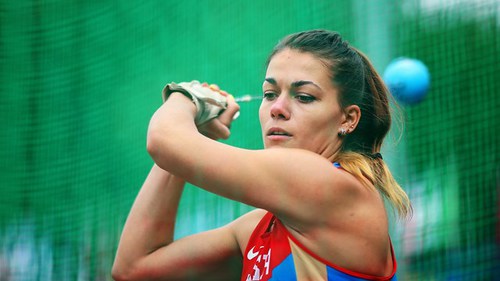RelatedPosts
Impressions from the Kadriorg Stadium
Not until I browsed through the official programme on the morning after the conclusion of the European Under-23 Championships did I realise that I spent four days in an athletics arena steeped in history.
Situated about two kilometres from the Old Town, the 5000-seater on the edges of the Kadriorg Park played host to the GDR vs. USSR athletics match in 1986. With opportunities for Eastern Bloc athletes to compete on the commercial circuit few and far between, these international matches assumed a huge significance second only to the major championships.
As a whole, the stadium records are certainly comparable – if not superior – to some of the lucrative Grand Prix meets on the European circuit, and most of them were set at that international match. Heike Drechsler was at her pomp in 1986 and the East German set a world long jump record of 7.45m and won the 200m in 22.13. Yuriy Sedykh broke the world hammer record with 86.66m while his wife Natalya Lisovskaya won the shot put with 21.70m before improving the stadium record to 22.55m two years later in the build-up to the 1988 Olympics.
As an aside, their daughter Alexia finished fourth in the hammer final last weekend while her parents were in town to assist with the medal ceremonies for their respective events.
The world has changed immeasurably since that GDR vs. USSR match, and political events have to a very large extent precipitated change in the sport: Lisovskaya and Sedykh, who both thrived under the Soviet set-up in the 1980s, have resided in France for nearly two decades and sport as a whole has assumed a lesser political significance since the days of the Cold War.
Drug testing was also virtually non-existent at the time, and increasingly rigorous testing methods and investment in anti-doping have since scaled down our perceptions of what can be achieved naturally. Suffice to say, these stadium records from the 1980s will stand the test of time.
Nearly thirty years after Lisovskaya was churning out 22 metres throws for fun, the climax of the women’s shot put final in Tallinn elicited a roar from the sparse crowd congregated at the far end of the stadium. In a dramatic conclusion to the first final of the champs, Viktoriya Kolb from Belarus pinched the title from long-time leader Shanice Craft with the penultimate throw of the competition.
Her winning mark of 17.47m was more than five metres adrift of Lisovskaya’s formidable European under-23 record but this was immaterial in the context of the competition. The cliche that records are there to be broken might not ring true for the current crop of women’s throwers faced with a seemingly impenetrable glass ceiling but a competition between two evenly matched athletes can still thrill a crowd, regardless of the winning mark.
A good champs for the front runner
The art of front running might be on the path to extinction but this tactic showed some signs of survival in Tallinn.
Regardless of Ali Kaya’s roots and age, the Kenyan-turned Turk wowed the crowds in the Kadriorg Stadium with his gun-to-tape efforts in the 5000m and 10,000m. In an elixir to the all-too-familiar sit-and-kick affairs, Kaya started both races at close to world record pace en route to championship records of 13:20.16 and 27:53.38.
Kaya’s wins were a demonstrations of his in superiority at under-23 but Liv Westphal ground out the women’s 5000m from the gun and only broke the last challenger on the final lap to take the title in 15:30.61. Recovering from an Evan Jager-esque fall on the last lap, Kaya’s team-mate Tugba Guvenc quickly got back on to her feet to win the steeplechase in a gun-to-tape champs record of 9:36.14.
Running from the front at the championships might be a high risk ploy – and one which is increasingly rare – but it can work. Fans pay to be entertaining and running hard from the gun is a tactic which can endear a crowd.
Nool’s legacy lives on
It says something about Erki Nool’s impact that six Estonian decathletes reached the qualifying standard for the European Under-23 Championships. Janek Oiglane told journalists at the pre-champs press conference he thought he was “a bit lucky” to make the team but his bronze medal was won entirely through his own doing. The 21-year-old propelled himself into medal contention with an excellent season’s best of 69.15m in the javelin before closing with a strong 1500m to take the bronze medal with a PB of 7945. Oiglane translates to justice in Estonian, and it only seemed fair the terrific hosts claimed at least one medal from the championships. And how fitting that Oiglane received his bronze medal from Nool himself.
Author

Larry Eder has had a 52-year involvement in the sport of athletics. Larry has experienced the sport as an athlete, coach, magazine publisher, and now, journalist and blogger. His first article, on Don Bowden, America's first sub-4 minute miler, was published in RW in 1983. Larry has published several magazines on athletics, from American Athletics to the U.S. version of Spikes magazine. He currently manages the content and marketing development of the RunningNetwork, The Shoe Addicts, and RunBlogRun. Of RunBlogRun, his daily pilgrimage with the sport, Larry says: "I have to admit, I love traveling to far away meets, writing about the sport I love, and the athletes I respect, for my readers at runblogrun.com, the most of anything I have ever done, except, maybe running itself." Also does some updates for BBC Sports at key events, which he truly enjoys. Theme song: Greg Allman, " I'm no Angel."
View all posts





















